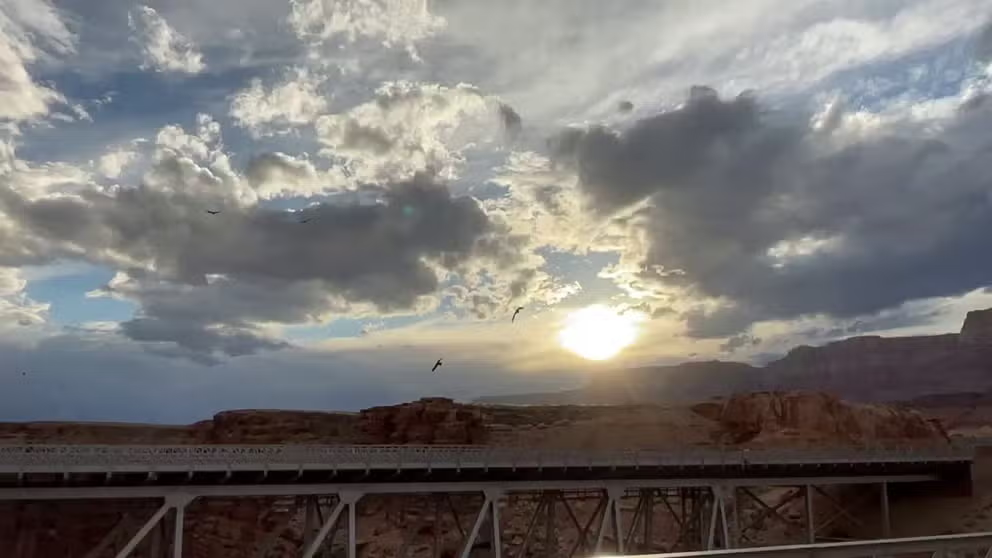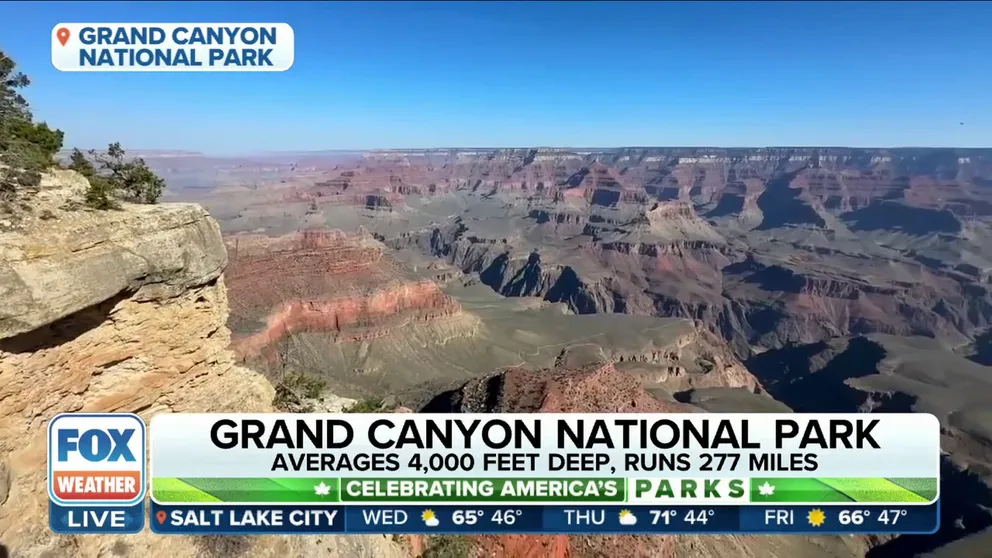Endangered California condors compete for love on Valentine's Day: It's complicated
The California condor has been protected as an endangered species since 1967, with the National Park Service saying only 561 remained at the end of 2022, and despite being on the brink of extinction, it keeps clawing its way back.
Watch: California condors fly above Navajo Bridge in Arizona
Video provided by The Peregrine Fund show California condors flying high above Navajo Bridge in Arizona.
MARBLE CANYON, Ariz. – It’s a Valentine’s Day story we’re all familiar with – love, loss and determination to rise above the ashes. But this story isn’t about people. It’s about two endangered California condors in the Southwest trying to navigate the complicated journey of love.
Outdoor clothing company KÜHL and The Peregrine Fund shared the incredible story of these majestic birds that mate for life, but when faced with a series of unfortunate events combined with human impacts, it’s clear that the bird species isn’t giving up without a fight.
The California condor has been protected as an endangered species since 1967, with the National Park Service saying only 561 remained at the end of 2022, and despite being on the brink of extinction, it keeps clawing its way back.
GRAND CANYON NATIONAL PARK IS COUNTRY'S MOST DEADLY, REPORT SAYS
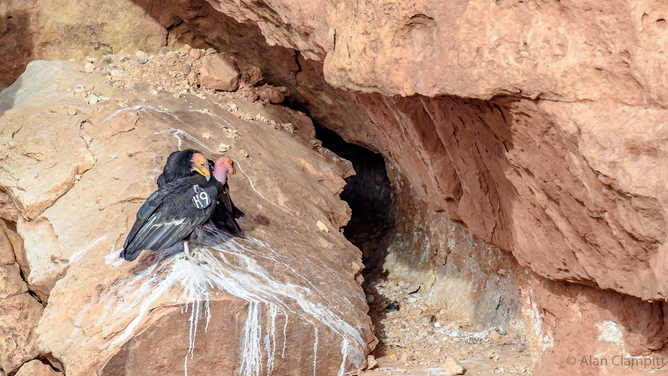
A photo showing California condors.
(Alan Clampitt)
The story begins at the Navajo Bridge in Marble Canyon in Arizona. It's situated along the Colorado River, partially within the Glen Canyon National Recreation Area and Grand Canyon National Park.
According to information provided by KÜHL, a pair of condors – male #619 and female #775 – were first spotted together in February 2022 and laid an egg later that spring. When the chick hatched, it was the #1150th condor hatched in the recovery program that is meant to prevent the species from going extinct.
The first few months of #1150's life were normal. They lived on a cliff edge, and he took his first flight on Nov. 12, 2022. But he had another year to spend with his parents to learn the ropes.
But then, tragedy struck.
7 THINGS YOU SHOULD KNOW ABOUT GRAND CANYON NATIONAL PARK
Exploring the diversity and beauty of Grand Canyon National Park
Grand Canyon National Park is considered one of the finest examples of arid-land erosion in the world. Incised by the Colorado River, the canyon is immense, averaging 4,000 feet deep for its entire 277 miles. FOX Weather's Robert Ray explores the diversity and beauty.
His mother died in March 2023 due to Highly Pathogenic Avian Influenza (HPAI). According to KÜHL, the bird flu claimed 21 condor lives and set the California condor recovery program back 10 years.
Despite the huge loss, #619 raised his chick on his own.
"Fortunately, #619 is an incredibly devoted father. He continued to feed #1150 and keep a watch on him when he began to explore the Grand Canyon while both escaped the grasp of HPAI," said Tim Hauck, Project Director for the California Condor Reintroduction Program. "#1150 is now fully independent and able to find food on its long flights over the high desert country."
CAN YOU NAME ALL 7 NATURE WONDERS OF THE WORLD?
The new chapter begins
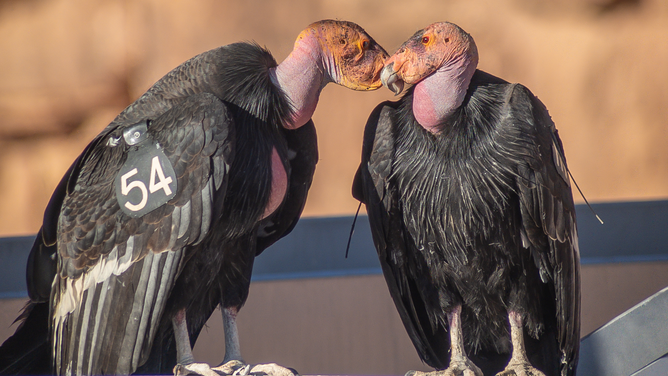
A photo showing California condors.
(Alan Clampitt)
Much like swans, California condors mate for life. But when faced with the loss of a loving partner, it frequently means the beginning of another quest for the continuity of the species.
And for #619, that quest led him to a new love – #741. Another female and potential new partner.
But soon after the courtship began, another setback occurred.
A health check revealed #619 had lead poisoning, likely from eating animal remains that were shot with lead-based ammunition. And then, after he was treated and released, #741 was also trapped and treated for lead poisoning.
She, too, was treated and released, and hope was rekindled that their love could be restored.
And then things got complicated.
Enter the other male
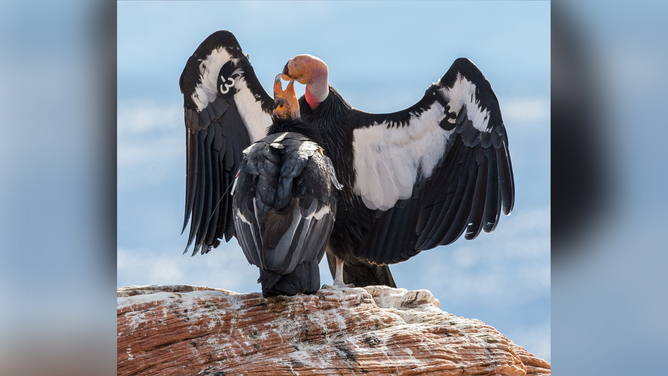
A photo showing California condors.
(John Sherman)
The hopeful love story between #619 and #741 got more complicated when another male, #354, entered the picture.
According to KÜHL, #354 is a dominant presence at Navajo Bridge. He has a successful mating history and seems determined to destroy the budding relationship between #619 and #741.
KÜHL said the assertive displays and pursuit of #741 have signaled a brewing battle of dominance and affection in a natural yet intense, dramatic display playing out outdoors.
And now, as #619 and #354 battle for the attention of #741, it remains unknown who will come out victorious.
Humans having effect on California condor survival
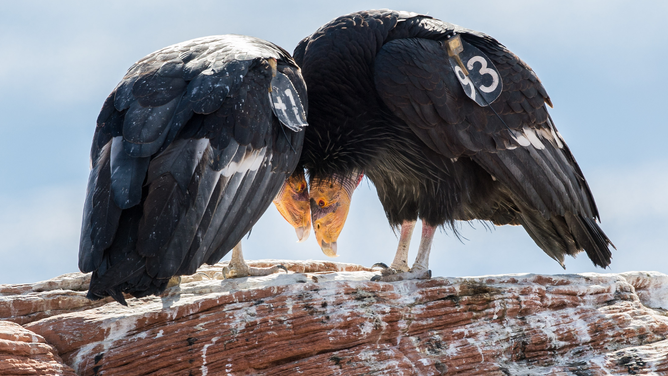
A photo showing California condors.
(John Sherman)
As the love story between #619, #354 and #741 continues to unfold, it's important to note that it's not only diseases like HPAI and natural predators in nature that threaten the species. Humans, too, are having an impact.
KÜHL and The Peregrine Fund say the issue of microtrash is an example.
While they scavenge for bone chips to supplement their calcium, which is especially crucial during the egg-laying period, California condors often mistake small pieces of trash for food.
That can have a tragic outcome because they can't be digested. And to make matters even worse, the microtrash can be unintentionally fed to their nestlings.
7 FACTS ABOUT US NATIONAL PARKS

A photo showing a California condor flying above Navajo Bridge in Arizona.
(The Peregrine Fund)
"Being vultures, condors not only eat dead animals but they also have been observed eating small pieces of bone. Although extremely intelligent, condors can’t always tell the difference between small pieces of trash and pieces of bone," Hauck said. "These objects cannot be digested and can cause impaction, ultimately leading to starvation and even death if not caught in time.
People are reminded to be conscious of their behavior, especially in natural habitats, and to adhere to the "Leave No Trace" principles.
